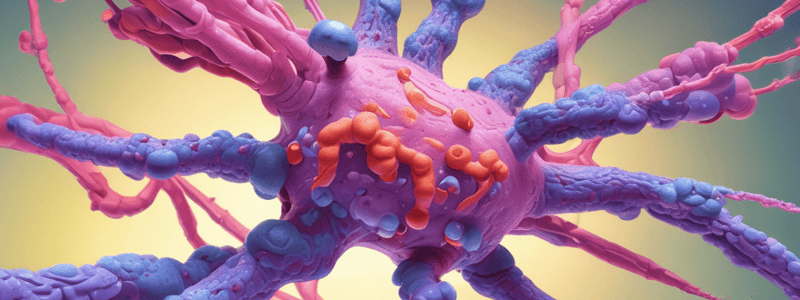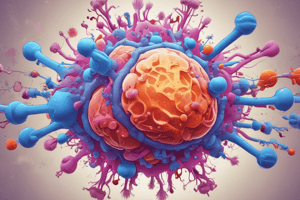Podcast
Questions and Answers
Binding can activate the cells to perform some biological ______.
Binding can activate the cells to perform some biological ______.
functions
IgG constitutes about ______% of total Igs of the body.
IgG constitutes about ______% of total Igs of the body.
70-80
IgG has the longest ______-life of 23 days.
IgG has the longest ______-life of 23 days.
half
IgG has four subclasses- IgG1, IgG2, IgG3 and ______.
IgG has four subclasses- IgG1, IgG2, IgG3 and ______.
IgM has the highest ______ weight, and maximum sedimentation coefficient (19S).
IgM has the highest ______ weight, and maximum sedimentation coefficient (19S).
IgM exists in both ______ and pentameric forms.
IgM exists in both ______ and pentameric forms.
IgA constitutes about ______% of total serum Ig.
IgA constitutes about ______% of total serum Ig.
Dimeric IgA is composed of two ______ units joined by a J chain.
Dimeric IgA is composed of two ______ units joined by a J chain.
An antibody is a specialized ______ produced from activated B cells
An antibody is a specialized ______ produced from activated B cells
Antibody and ______ are used interchangeably to represent the physiological and functional properties of the same molecule
Antibody and ______ are used interchangeably to represent the physiological and functional properties of the same molecule
There are five classes of ______ recognized: IgG, IgA, IgM, IgD, and IgE
There are five classes of ______ recognized: IgG, IgA, IgM, IgD, and IgE
An antibody molecule is a ______ shaped heterodimer composed of four polypeptide chains
An antibody molecule is a ______ shaped heterodimer composed of four polypeptide chains
The ______ region represents the antigen binding site of the antibody
The ______ region represents the antigen binding site of the antibody
Antibody coating the target cell binds to ______ through its Fc receptor
Antibody coating the target cell binds to ______ through its Fc receptor
Phagocytic cells, lymphocytes, platelets, mast cells, NK cells, eosinophils, and basophils bear ______ receptors that bind to the Fc region of immunoglobulins
Phagocytic cells, lymphocytes, platelets, mast cells, NK cells, eosinophils, and basophils bear ______ receptors that bind to the Fc region of immunoglobulins
Each H and L chain has two ends: an ______ terminal end and a carboxyl terminal end
Each H and L chain has two ends: an ______ terminal end and a carboxyl terminal end
Secretory IgA provides good protection to the immunologically immature infant ______.
Secretory IgA provides good protection to the immunologically immature infant ______.
IgA exists in two ______ isotypes: IgA1 and IgA2.
IgA exists in two ______ isotypes: IgA1 and IgA2.
IgE is the only ______ labile antibody, inactivated at 56º C in one hour.
IgE is the only ______ labile antibody, inactivated at 56º C in one hour.
IgD is found as membrane Ig on the surface of ______ cells and acts as a B cell receptor.
IgD is found as membrane Ig on the surface of ______ cells and acts as a B cell receptor.
The five classes of Igs and their subclasses are called as ______.
The five classes of Igs and their subclasses are called as ______.
Isotypic variation refers to the variation in the amino acid sequences of the constant region of their ______ chains.
Isotypic variation refers to the variation in the amino acid sequences of the constant region of their ______ chains.
Flashcards are hidden until you start studying
Study Notes
Antibody Structure
- An antibody molecule is a 'Y-shaped' heterodimer composed of four polypeptide chains: two identical light (L) chains and two identical heavy (H) chains.
- The molecular weight of L chains is 25,000 Da each, and H chains have a molecular weight of 50,000 Da or more.
- The chains are bound together by disulfide bonds and noncovalent interactions.
Antibody Regions
- Each H and L chain consists of two regions: variable and constant regions.
- The variable region represents the antigen binding site of the antibody.
Functions of Immunoglobulins
- Effector functions are mediated by the Fc region, including fixation of complement, binding to various cell types, and activation of cells to perform biological functions.
- Immunoglobulins can cross the placenta and provide immunity to the fetus and newborn.
Immunoglobulin G (IgG)
- Constitutes about 70-80% of total Igs in the body.
- Has the longest half-life of 23 days and the highest serum concentration.
- IgG has four subclasses: IgG1, IgG2, IgG3, and IgG4, which differ in their biological functions, hinge region length, and number of disulphide bridges.
- Functions: crosses placenta, provides immunity to fetus and newborn, fixes complement, mediates phagocytosis, and neutralizes toxins.
Immunoglobulin M (IgM)
- Has the highest molecular weight and sedimentation coefficient (19S).
- Exists in both monomeric and pentameric forms.
- Functions: provides immediate immunity, fixes complement, acts as an opsonin, mediates agglutination, and is an antigen receptor.
Immunoglobulin A (IgA)
- Exists in both monomeric and dimeric forms.
- Secretory IgA provides local or mucosal immunity, effective against bacteria and viruses, and is found in body secretions like milk, saliva, tears, and intestinal and respiratory tract mucosal secretions.
Immunoglobulin E (IgE)
- Has the lowest serum concentration, shortest half-life, and minimum daily production.
- Is heat-labile and has affinity for the surface of tissue cells, especially mast cells.
- Mediates type I hypersensitivity reactions and is elevated in helminthic infections.
Immunoglobulin D (IgD)
- Is found as membrane Ig on the surface of B cells, acting as a B cell receptor along with IgM.
- Has the highest carbohydrate content among all the Igs, but its functions are unknown.
Studying That Suits You
Use AI to generate personalized quizzes and flashcards to suit your learning preferences.




